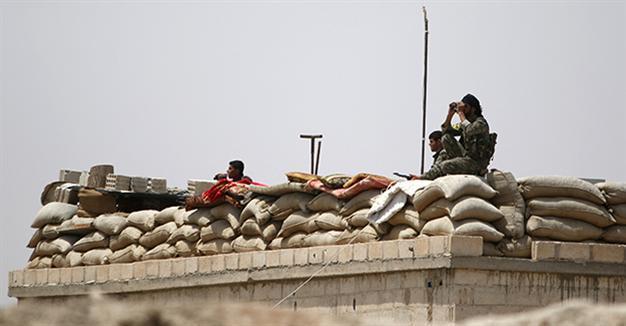ISIS: A History
William Armstrong - william.armstrong@hdn.com.tr

Fighters of the Syrian Democratic Forces take an overwatch position against ISIS in Raqqa, Syria. REUTERS photo
‘ISIS: A History’ by Fawaz Gerges (Princeton University Press, 384 pages, $28)You have probably seen the brilliant one-sentence, one-paragraph “explanation” of ISIS by the satirist Karl Sharro. That explanation makes light of the demand for simple answers to complex phenomena. There is plenty of excellent analysis out there of ISIS and its origins. But of course there is also a lot of rubbish. “ISIS: A History” by London School of Economics professor Fawaz Gerges is perhaps the most informative, clearly expressed, sober book on the subject. It untangles the web of regional and global crises that led to the horror of ISIS. It doesn’t add anything new, but it does give essential context and perspective to a sensational, headline-grabbing group.
 There is plenty of blame to go around for the rise of ISIS. Al-Qaeda’s ideology already had roots across the Middle East, but it could only flourish in the chaos that followed the U.S.-led invasion of Iraq in 2003. ISIS is a product of the breakdown of state institutions and crisis of governance engulfing the Arab Middle East, of the clash of identities between Sunni and Shia Muslims, and of the expanding Salafi-jihadist ideology. All of these things were exacerbated by the U.S. invasion and occupation of Iraq. Gerges describes that calamity as “the most important variable in the emergence of Al-Qaeda in Iraq and its subsequent rebirth as ISIS … a defining moment in the reconstruction of a potent pan-Sunni identity in the wider region.”
There is plenty of blame to go around for the rise of ISIS. Al-Qaeda’s ideology already had roots across the Middle East, but it could only flourish in the chaos that followed the U.S.-led invasion of Iraq in 2003. ISIS is a product of the breakdown of state institutions and crisis of governance engulfing the Arab Middle East, of the clash of identities between Sunni and Shia Muslims, and of the expanding Salafi-jihadist ideology. All of these things were exacerbated by the U.S. invasion and occupation of Iraq. Gerges describes that calamity as “the most important variable in the emergence of Al-Qaeda in Iraq and its subsequent rebirth as ISIS … a defining moment in the reconstruction of a potent pan-Sunni identity in the wider region.” Key to this was the deliberate dismantling of Iraqi state institutions by the occupying forces after 2003. A sectarian-based political system was imposed, polarizing the country along Sunni-Shia lines, emphasizing ethno-religious identity over national Iraqi identity:
The dissolution of the army, which had stood at 300,000 strong, coupled with the de-Baathification campaign, which dismissed people based on rank and affiliation, not behavior, and which was mainly seen as a punitive and discriminatory policy against Sunnis by Iraqi’s newly installed Shia rulers, left widespread feelings of injustice and bitterness within the Sunni community.
Repression, tyranny and foreign wars created huge rifts within Iraqi society. To find solace and security, many Iraqis retreated to local, provincial, sectarian loyalties over greater national identity. The Shia-based government of former Prime Minister Nouri al-Maliki fanned the flames of Sunni jihadist insurgency. Today, many Iraqi Sunnis tolerate ISIS as the enemy of their enemy; the last defenders of the Sunnis against the Baghdad regime. Gerges quotes activist Omar Fawwaz, who lives in Anbar province and does not back the group, saying that “for ordinary Sunnis ISIS is the last line of defense of their existence, identity, and property.”
ISIS developed out of Al-Qaeda in Iraq (IQI) and the Islamic State of Iraq (ISI), prominent in the insurgency against U.S. forces and the fight against local Shias. Gerges’ book is excellent at explaining how the shift from al-Qaeda to ISIS happened, the tactical differences between various Sunni jihadi groups, and the ideological schisms between them. Although it seemed defeated by 2009, the bloody chaos of civil war across the border in Syria gave ISI a lifeline after 2011. Carving territory out of both, the group - led by Abu Bakr al-Baghdadi from 2010 - earned global attention with its acts of shocking brutality and proclamation of an Islamic caliphate.
In Syria, the causes that allowed ISIS to plant roots were similar to those in Iraq: The fraying and delegitimization of state institutions and the retreat to sectarian identity amid violent meltdown. ISIS is mostly a morbid symptom - rather than a primary cause - of the failure of Arab states to represent the interests of their citizens. As in Iraq, ISIS defended its struggle in Syria through the framework of identity rather than ideology. It emphasized a distinct pan-Sunni identity, in contrast to the pan-Shia identity represented by the increasingly Iran-backed Damascus regime. “Ideologically and militarily, ISIS was seen as a powerful force that could deliver Syrians from bondage by toppling Assad and establishing a centralized Sunni rule in Damascus and Baghdad, a feat that none of its Islamist rivals could accomplish.” In sum, Gerges writes:
ISIS has successfully developed a narrative rooted in a pan-Sunni identity that is intrinsically opposed to what it portrays as an aggressive and expansionist Shia ideology that has infiltrated and is engulfing the Islamic world. ISIS’s anti-Shia, anti-Iranian program is the most powerful card it has played in Iraq and Syria, and it has so far proved to be a potent recruiting tool. Salafi-jihadists have exploited a creeping communal rift that deepened and widened after the U.S.-led invasion of Iraq in 2003.
That intra-communal conflict has been further stoked by the regional proxy wars that poured gasoline on raging fires in Syria, Iraq, Libya, Yemen, and elsewhere. In Gerges’ words, “The new regional cold war between the leader of Arabian Sunni Islam, Saudi Arabia, and the leader of Shia Islam, (Persian) Iran, provided ammunition to non-state actors like Al-Qaeda and ISIS by diverting the path of the struggle away from social and political emancipation toward geostrategic and sectarian rivalry.” The steady stream of weapons into the maelstrom and Turkey’s open-border policy allowed extremist groups to flourish.
While on the ground in the Levant its focus and appeal is heavily based on Sunni identity, for sympathizers globally its general symbolic value is more potent. That is highlighted by the example of Omar Mateen, the killer of 49 people at a gay club in Orlando on June 12. Confusingly, Mateen voiced support for both the Shia militia Hezbollah and the Sunni jihadists of ISIS before committing the massacre.
The lure of the caliphate imbues recruits with “a greater purpose in life: “To be part of a historical mission to restore unity and help bring about redemption and salvation,” Gerges writes. “It provides them with a strong sense of collective identity, a transformative experience, particularly young Muslims who do not feel integrated or who feel excluded from Western societies.” This book does not go into much detail about the attraction of ISIS for some western Muslims who cannot physically go to ISIS territory. But it is their hearts and minds that are likely to be the more important front in the coming years.
*Follow the Turkey Book Talk podcast via iTunes here, Stitcher here, Podbean here, or Facebook here.










